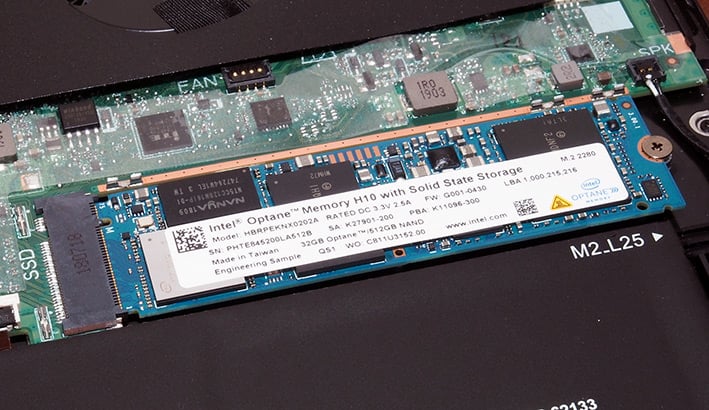Intel Optane Memory H10 Review: Hybrid SSD Storage Acceleration
Intel Optane Memory H10 - Test Setup And Benchmarks
That said, the HP Spectre X360 13” machine we were set up with was fairly high-end. The system featured an 8th Gen Core i7-8565U quad-core / eight-thread processor, with 16GB of RAM. For reference purposes, we compared the performance of the Optane Memory H10 – with and without Intel’s caching algorithm enabled – to an Intel SSD 760p standalone SSD that had the necessary OS image for the machine. We, however, installed all of the benchmarks and applications used for testing, except for Microsoft Office, which came pre-installed by HP.

We began our testing with some common benchmarks, just to set some baseline expectations. We’ve got three sets of numbers in each chart, one from the Intel SSD 760P and two for the Optane Memory H10 -- one with Optane Memory caching enabled, and another with it disabled. The reason we wanted to show you the performance of the H10 with its Optane Memory disabled is to present the “worst” cache scenario, where nothing is cached on the 3D Xpoint Optane memory.
Let’s start with the ATTO Disk Benchmark. ATTO is a "quick and dirty" type of disk benchmark that measures transfer speeds across a specific volume length. It measures raw transfer rates for both reads and writes and graphs them out in an easily interpreted chart. We chose .5KB through 64MB transfer sizes and a queue depth of 6 over a total max volume length of 256MB. ATTO's workloads are sequential in nature and measure bandwidth, rather than I/O response time, access latency, etc.
|


|




CrystalDiskMark provided some interesting results. In CrystalDiskMark's sequential test, both sides of the Optane Memory H10 are working in conjunction and we see sequential transfers in-line with Intel's 2400MB/s / 1800MB/s read / write specs. In the higher queue depth 4K transfer tests, the H10 exhibits relatively strong read performance, but actually trails in writes versus the SSD 760P and even the H10 when caching is disabled. In the QD1 4K test, the H10 shows just how strong it can be in the read test, which more than doubles the performance of the SSD 760P.
|
We like PCMark's Storage 2.0 benchmark module for its real-world application measurement approach to testing. PCMark offers a trace-based measurement of system response times under various scripted workloads of traditional client / desktop system operation. From simple application start-up performance, to data streaming from a drive in a game engine, and video and photo editing with Adobe applications, we are comfortable that these tests reasonably illustrate the performance profile of SSDs in an end-user / consumer PC usage model, more so than a purely synthetic transfer test.



In the trace-based PCMark Storage Benchmark, the Optane Memory H10 clearly outpaces the SSD 760P. The H10 is faster than the SSD 760P in every sub-test, offers more peak bandwidth, and ultimately leads in terms of the overall score as well.







